Improved insulin sensitivity and body composition, irrespective of macronutrient intake, after a 12 month intervention in adolescents with pre-diabetes; RESIST a randomised control trial
- PMID: 25422027
- PMCID: PMC4252020
- DOI: 10.1186/s12887-014-0289-0
Improved insulin sensitivity and body composition, irrespective of macronutrient intake, after a 12 month intervention in adolescents with pre-diabetes; RESIST a randomised control trial
Abstract
Background: A higher protein to carbohydrate ratio in the diet may potentiate weight loss, improve body composition and cardiometabolic risk, including glucose homeostasis in adults. The aim of this randomised control trial was to determine the efficacy of two structured lifestyle interventions, differing in dietary macronutrient content, on insulin sensitivity and body composition in adolescents. We hypothesised that a moderate-carbohydrate (40-45% of energy), increased-protein (25-30%) diet would be more effective than a high-carbohydrate diet (55-60%), moderate-protein (15%) diet in improving outcomes in obese, insulin resistant adolescents.
Methods: Obese 10-17 year olds with either pre-diabetes and/or clinical features of insulin resistance were recruited at two hospitals in Sydney, Australia. At baseline adolescents were prescribed metformin and randomised to one of two energy restricted diets. The intervention included regular contact with the dietician and a supervised physical activity program. Outcomes included insulin sensitivity index measured by an oral glucose tolerance test and body composition measured by dual-energy x-ray absorptiometry at 12 months.
Results: Of the 111 adolescents recruited, 85 (77%) completed the intervention. BMI expressed as a percentage of the 95th percentile decreased by 6.8% [95% CI: -8.8 to -4.9], ISI increased by 0.2 [95% CI: 0.06 to 0.39] and percent body fat decreased by 2.4% [95% CI: -3.4 to -1.3]. There were no significant differences in outcomes between diet groups at any time.
Conclusion: When treated with metformin and an exercise program, a structured, reduced energy diet, which is either high-carbohydrate or moderate-carbohydrate with increased-protein, can achieve clinically significant improvements in obese adolescents at risk of type 2 diabetes.
Trial registration: Australian New Zealand Clinical Trail Registry ACTRN12608000416392 . Registered 25 August 2008.
Figures


References
-
- Abete I, Astrup A, Martinez JA, Thorsdottir I, Zulet MA. Obesity and the metabolic syndrome: role of different dietary macronutrient distribution patterns and specific nutritional components on weight loss and maintenance. Nutr Rev. 2010;68:214–231. doi: 10.1111/j.1753-4887.2010.00280.x. - DOI - PubMed
-
- Paddon-Jones D, Westman E, Mattes RD, Wolfe RR, Astrup A, Westerterp-Plantenga M. Protein, weight management, and satiety. Am J Clin Nutr. 2008;87:1558S–1561S. - PubMed
Publication types
MeSH terms
Substances
Associated data
LinkOut - more resources
Full Text Sources
Other Literature Sources
Medical

